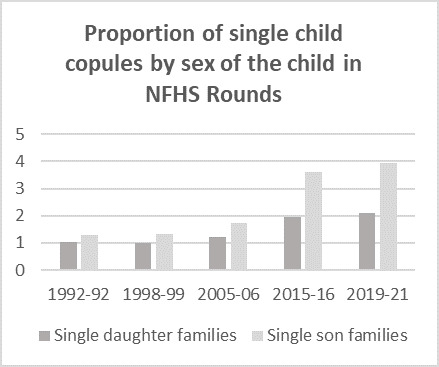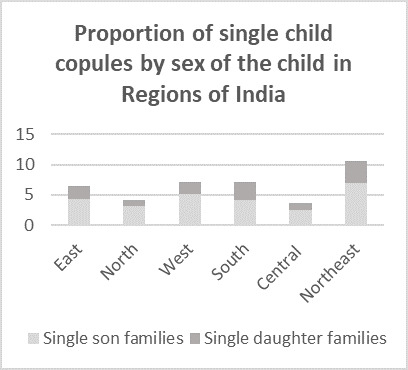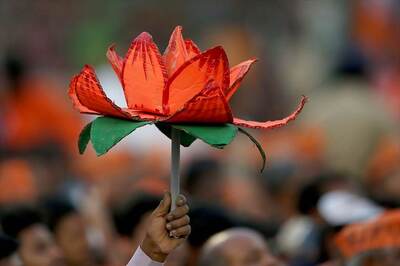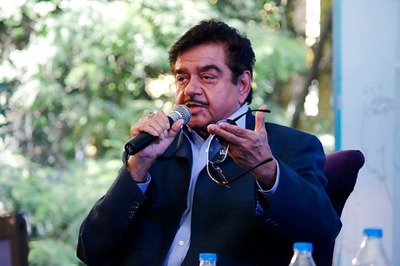
views
When the heat of the general election was really up, Ajit Pawar took his address beyond religion, appeasement politics, and the array of achievement announcements made by the different political parties in power. On April 17, in a political rally in Baramati, Maharashtra, Pawar raised his concern about the declining sex ratio un-favouring the girls in Maharashtra. His reference to Draupadi’s marriage to the five Pandava brothers may not be an accurate one, but the situation he referred to needs strong attention from the policymakers.
Son preference is not a new phenomenon in many of the countries worldwide. This becomes more evident during fertility transitions when attitudes towards sons do not change. In high-fertility societies, parents typically achieve their desired number of sons naturally. However, as societies transition to lower fertility rates, couples often resort to eliminating girl children to ensure they have the desired number of sons. The worst reflections of son preference are visible in India and China where the sex ratio favours the son.
The natural sex ratio at birth (SRB) is to be around 950 girls per 1000 boys at birth. But the census count of 2020 observes a sex ratio of around 909 in China which is still quite low despite improvement observed since 2008. Similarly, in India, the Sample Registration System provides information on SRB. The SRB in the period 2018-20 as published in the SRS Bulletin 2020 was 907 which is again far below the natural average expected. The only ray of hope for India is that there is a secular increase from 876 in 2005 and 898 in 2014-16.
To change the attitude of the son preference and to improve the attitude towards the girl child, a wide range of schemes have been introduced by the government such as the Balika Samridhi Yojana (1997), Ladli Lakshmi Yojana of Madhya Pradesh (2007), Mukhyamantri Rajshri Yojana of Rajasthan (2016), Ladli Scheme of Delhi (2008), and Kanyashree Prakalpa of West Bengal (2013). A closer examination of these schemes reveals their primary objective: to enhance the well-being of girls by promoting their continued education and preventing them from being perceived as financial burdens on their families at the time of marriage.
However, a closer analysis of the NFHS-V data reveals that son preference has become more evident among families who have limited their family size to one child. At the country level, the ratio of single-daughter to single-son families stood out at 514:1000, which is alarming. Further detailed analysis reveals that this ratio is worst among those who reside in rural areas, are resource-rich, living in joint families and in the northern states of India.
India introduced ultrasound technology for detecting foetal anomalies in the early 80s. However, soon the technology started being used for sex determination of the foetus among the wealthier. The country then introduced the Pre-conception and Prenatal Diagnostic Technique Act in 1994 (PC-PNDT) where the use of technology for prenatal sex determination was made a punishable offence. The advancement of technology even made it possible to select the sex of the unborn child at the pre-conception stage. Accordingly, stronger amendments were made to the Act. Even then, foeticide and sex-determination remained a ground reality and the reflection is visible in the sex ratio.
Clinicians are part of a larger society and thus change in the societal attitude towards girl children is essential along with stringent implementation of the Act, highlighting the role of the doctors. The strong preference for sons and strong willingness for small families is being negotiated through the illegal use of technology. This fact was realised by the BJP immediately after assuming power at the Centre in 2014. Without any delay, Prime Minister Narendra Modi launched a clear-cut programme in 2015 instead of keeping the lid on the worsening sex ratio.
The loud and clear call for Beti Bachao (save the girl child) followed by Beti Padhao (wellbeing of the girl child through education) has become the need of the hour. It was a wise realisation as India is steadily marching towards small family norms. The single-child families are expected to rise especially in the high fertility areas of northern states where the sex ratio among single-child families is extremely skewed towards boys. If continued with this tendency, the sex ratio will worsen further. Beti Bachao remains a social call and it is a happy moment to see that it appeared in the political campaign too.
When the heat of the general election was really up, Ajit Pawar took his address beyond religion, appeasement politics, and the array of achievement announcements made by the different political parties in power. On April 17, in a political rally in Baramati, Maharashtra, Pawar raised his concern about the declining sex ratio un-favouring the girls in Maharashtra. His reference to Draupadi’s marriage to the five Pandava brothers may not be an accurate one, but the situation he referred to needs strong attention from the policymakers.
Son preference is not a new phenomenon in many of the countries worldwide. This becomes more evident during fertility transitions when attitudes towards sons do not change. In high-fertility societies, parents typically achieve their desired number of sons naturally. However, as societies transition to lower fertility rates, couples often resort to eliminating girl children to ensure they have the desired number of sons. The worst reflections of son preference are visible in India and China where the sex ratio favours the son.
The natural sex ratio at birth (SRB) is to be around 950 girls per 1000 boys at birth. But the census count of 2020 observes a sex ratio of around 909 in China which is still quite low despite improvement observed since 2008. Similarly, in India, the Sample Registration System provides information on SRB. The SRB in the period 2018-20 as published in the SRS Bulletin 2020 was 907 which is again far below the natural average expected. The only ray of hope for India is that there is a secular increase from 876 in 2005 and 898 in 2014-16.
To change the attitude of the son preference and to improve the attitude towards the girl child, a wide range of schemes have been introduced by the government such as the Balika Samridhi Yojana (1997), Ladli Lakshmi Yojana of Madhya Pradesh (2007), Mukhyamantri Rajshri Yojana of Rajasthan (2016), Ladli Scheme of Delhi (2008), and Kanyashree Prakalpa of West Bengal (2013). A closer examination of these schemes reveals their primary objective: to enhance the well-being of girls by promoting their continued education and preventing them from being perceived as financial burdens on their families at the time of marriage.
However, a closer analysis of the NFHS-V data reveals that son preference has become more evident among families who have limited their family size to one child. At the country level, the ratio of single-daughter to single-son families stood out at 514:1000, which is alarming. Further detailed analysis reveals that this ratio is worst among those who reside in rural areas, are resource-rich, living in joint families and in the northern states of India.
India introduced ultrasound technology for detecting foetal anomalies in the early 80s. However, soon the technology started being used for sex determination of the foetus among the wealthier. The country then introduced the Pre-conception and Prenatal Diagnostic Technique Act in 1994 (PC-PNDT) where the use of technology for prenatal sex determination was made a punishable offence. The advancement of technology even made it possible to select the sex of the unborn child at the pre-conception stage. Accordingly, stronger amendments were made to the Act. Even then, foeticide and sex-determination remained a ground reality and the reflection is visible in the sex ratio.
Clinicians are part of a larger society and thus change in the societal attitude towards girl children is essential along with stringent implementation of the Act, highlighting the role of the doctors. The strong preference for sons and strong willingness for small families is being negotiated through the illegal use of technology. This fact was realised by the BJP immediately after assuming power at the Centre in 2014. Without any delay, Prime Minister Narendra Modi launched a clear-cut programme in 2015 instead of keeping the lid on the worsening sex ratio.
The loud and clear call for Beti Bachao (save the girl child) followed by Beti Padhao (wellbeing of the girl child through education) has become the need of the hour. It was a wise realisation as India is steadily marching towards small family norms. The single-child families are expected to rise especially in the high fertility areas of northern states where the sex ratio among single-child families is extremely skewed towards boys. If continued with this tendency, the sex ratio will worsen further. Beti Bachao remains a social call and it is a happy moment to see that it appeared in the political campaign too.


Bhaswati Das is Associate Professor, Centre for the Study of Regional Development, School of Social Science, JNU; Nowaj Sharif, Senior Research Fellow, Centre for the Study of Regional Development, School of Social Science, JNU. Views expressed in the above piece are personal and solely that of the author. They do not necessarily reflect News18’s views.


















Comments
0 comment